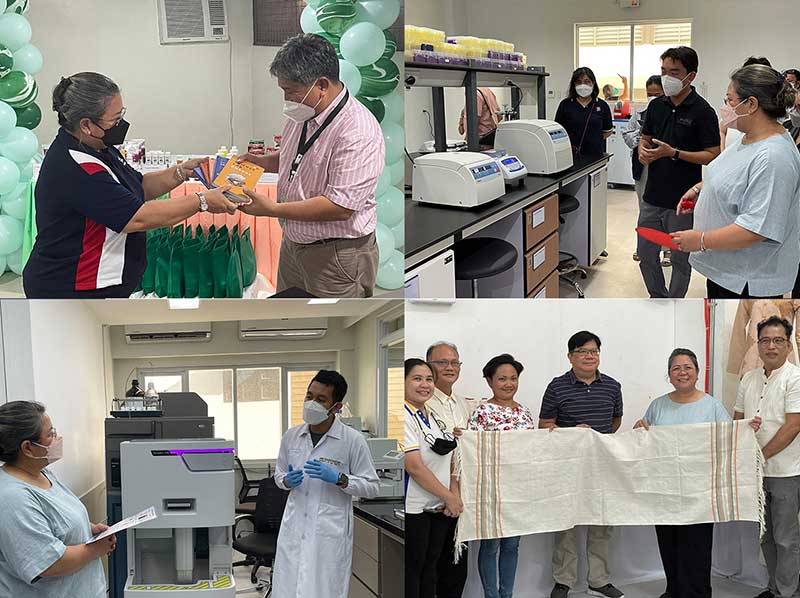
Department of Science and Technology’s (DOST) Science for Change Program (S4CP) carried out project visits focusing on aquaculture, textile, and pharma R&D projects of State Universities and Colleges (SUCs) and private institutions in Western Visayas.
S4CP is a nationwide program spearheaded by the former DOST Undersecretary for Research and Development (R&D), Dr. Rowena Cristina Guevara. During the visits, Usec. Guevara and the S4CP team were accompanied by personnel from DOST VI Regional Office to assess the status of S4CP projects as well as other R&D outputs in the region.
Their first stop was Herbanext Laboratories, Inc. in Negros Occidental. Currently, Herbanext is focusing their resources on herbal plants to encourage mass production of locally sourced herbal supplements to lessen the burden brought about by importation of raw materials. The company also encourages researchers to participate more actively in the commercialization of herbal supplements in order to gain a better understanding of the market. Herbanext was also the first beneficiary of the S4CP’s component program, Business Innovation through Science and Technology (BIST), they were able to procure professional-grade equipment which helped streamline product analyses for improved accuracy.
In addition, Herbanext also had the opportunity to launch its Applied Research and Innovation Laboratory (ARIL) through the BIST program. ARIL is aimed at helping government and academic researchers in the development of scaling-up processes for herbal ingredients and products. The laboratory’s specialties involve pilot-scale production of standardized botanical extracts, herbal drugs, food supplements, functional foods, herbal cosmetics, among others.
Afterward, the team paid a visit to the University of the Philippines Visayas (UPV) which houses the Mollusk R&D Center and the Philippine Genome Center (PCG). The former is known for focusing their research on the significance of mollusks to initiate R&D that will aid in developing related fields of aquaculture and fisheries.
This was followed by a trip to Iloilo Science and Technology University (ISAT-U) which is home to the Regional Yarn Production and Innovation Center (RYPIC) in Western Visayas. A center of natural textile innovation, the RYPIC provides technical assistance to micro, small, and medium enterprises (MSMEs) specializing in the garment industry throughout the region. In addition, they aim to produce yarn using locally-sourced natural textile fibers such as abaca, banana, and pineapple to reduce the burden of importing raw materials as well as create more organic textile rather than relying on synthetic garment material.
The team’s last stop was at the University of San Agustin (USA) where Dr. Jonel P. Saludes, Associate Vice President of the university, and Dr. Doralyn S. Dalisay, Director of the university’s Center for Chemical Biology and Biotechnology (C2B2) Laboratory, presented the various projects conducted in the campus which cover topics such as drug development and fisheries. Among the relevant projects include those dealing with drug development from Tawa-tawa and marine sediments. Moreover, a separate but still noteworthy project entitled, “Biofloc-based Nursery Tank Production of Shrimp for Quality and Sustainable Supply of Aquaculture Products in the New Normal” which, as the name implies, aims to enhance further the fisheries and aquaculture sector.
Furthermore, USA’s Nuclear Magnetic Resonance (NMR) Spectroscopy facility was also introduced to be utilized by the Tuklas Lunas program to determine molecular identity. The visit also covered the aforementioned C2B2 and the Center for Natural Drug Discovery and Development (CND3), both of which make use of studying microorganisms’ biochemical frameworks for developing drug treatments of rampant diseases, such as but not limited to tuberculosis, bacterial infection, dengue, malaria, cancer which affect Filipinos nationwide. The Natural Products Drug Discovery Program is at the heart of these laboratories’ operations.
Former Usec. Guevara pushed for the promotion of the R&D outputs. “R&D results should reach the intended users. It is through bringing research results to intended users that we can weave through change.” (KJRGagajena/DOSTVI-KMU)




















